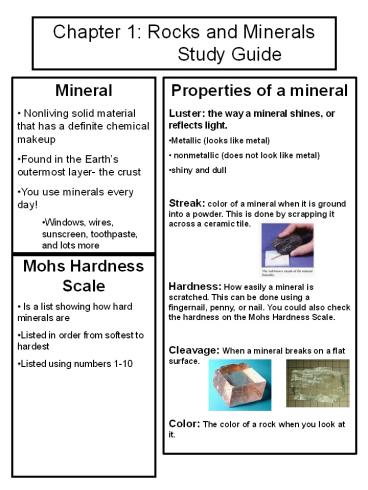Chapter 1: Rocks and Minerals Study Guide - PowerPoint PPT Presentation
1 / 3
Title: Chapter 1: Rocks and Minerals Study Guide
1
Chapter 1 Rocks and Minerals
Study Guide
- Mineral
- Nonliving solid material that has a definite
chemical makeup - Found in the Earths outermost layer- the crust
- You use minerals every day!
- Windows, wires, sunscreen, toothpaste, and lots
more
- Properties of a mineral
- Luster the way a mineral shines, or reflects
light. - Metallic (looks like metal)
- nonmetallic (does not look like metal)
- shiny and dull
- Streak color of a mineral when it is ground into
a powder. This is done by scrapping it across a
ceramic tile. - Hardness How easily a mineral is scratched. This
can be done using a fingernail, penny, or nail.
You could also check the hardness on the Mohs
Hardness Scale. - Cleavage When a mineral breaks on a flat
surface. - Color The color of a rock when you look at it.
- Mohs Hardness Scale
- Is a list showing how hard minerals are
- Listed in order from softest to hardest
- Listed using numbers 1-10
2
I am a GEOLOGIST I am a scientist who studies
rocks
- Rocks
- Rocks are solid material made up of one or more
minerals
- Three Types of Rocks
- Igneous Rocks
- Form when melted rock cools and hardens
- Minerals in the rocks form crystals
- Some igneous rocks formed by volcanoes
- Obsidian, basalt, and granite are types of
igneous rocks
- The Rock Cycle
- Shows the process that can change rocks
- A rock can change from one type of rock to
another
- Sedimentary Rocks
- Form when sand, bits of rocks, soil, and once
living things are pressed together and harden. - These materials are called sediments
- Sandstone and Limestone are types of sedimentary
rocks
- Metamorphic Rocks
- Rocks changed by heat and pressure from below the
Earths surface. - Gniess is formed from granite (an igneous rock)
that has undergone heat and pressure.
Weathering The breaking down of rocks into
smaller pieces called sediment
3
- Layers of the Earth
- Crust thinnest layer, made of the ocean floor
and the continents - Mantle thickest layer, between crust and the
core, upper part is soft, lower part is hard - Outer Core liquid
- Inner Core hard, dense ball that is the hottest
part of the Earth































